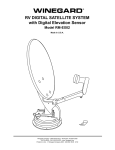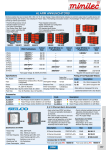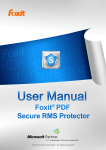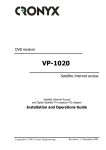Download Zephyr 700 User's Manual
Transcript
ELECTRONICS, LTD 700 SERIES SCPC Satellite Receivers ZEPHYRUS ELECTRONICS, LTD 168 South 122 East Avenue, Tulsa, OK 74128-2405 USA Phone 918-437-3333 Fax 918-438-7322 Web site http://www.big-z.com Email [email protected] Thank you for using our equipment. We will do our best to earn your continuing confidence in Zephyrus and our products. Any time you need information or help, give us a call at 918-437-3333 (US). It's a good idea to look the equipment over for any shipping damage as soon as it is received. If damage is discovered, contact and file a claim with the freight company. They are responsible to you. Our Limited Warranty is as follows: We will fix or replace any product that is defective within One year (Australia) after you receive it. We won't cover damage from accident or misuse. Warranty is FOB the factory or our servicing distributor. Our responsibility is limited to repair or replacement only and no other expenses or consequential damages. No other warranties apply. We hope it doesn't happen, but if you ever have a problem that requires you to send equipment back to us for repair or replacement, Please pack a note in with the device. Give us as much information as possible;-- what the problem is and anything you can tell us that might help solve it. Customer feedback is the last line and a very Whether your warranty has expired or not, customer support and assistance is the vital part of our overall quality control. backbone of our business. Our managment It will also help both of us if you will get an has a background in broadcasting, so we RMA number from the service technician you understand the seriousness of "equipment are talking with. We will certainly accept down." We'll do all we can. --Your referral products for service without a number, but any to a friend might even be our next sale! notes that the tech makes in his phone calls with you might not get tied to your unit when it gets here. We make quality affordable thankyou.sam OPERATING THE ZEPHYRUS 700 SERIES SCPC SATELLITE RECEIVER Table of Contents SECTION 1 General Information -An overview and summary description of the system describing features and design philosophy. -System specifications and typical operating criteria. SECTION 2 Front Panel Layout and Operation -Meter operation and calibration, control information. -Details of Readout Display and Keypad Data Entry. SECTION 3 Installation of the 700 Receiver system -Dish and polarity optimization. -Notes on signal quality problems. SECTION 4 SYSTEM OPERATION AND CUSTOMIZATION -Components to make up a 700 system. -External connections. -Locations and use of customer usable jumpers and internal adjustments. ZEPHYRUS ELECTRONICS, LTD 168 South 122nd East Avenue Tulsa, Oklahoma 74128-2405 USA Pho 918 437-3333 Fax 438-7322 MA700TBL.SAM Operating the Zephyrus 700 Series SCPC Satellite Receiver General information The 700 receiver system is contained in a 3½" frame and features microcomputer electronics that control and monitor operation of either one or two receiver modules and the LNB. Primary power is normally 117 vac with 240 volt units available. Rack mounting is optional. v Input signal to the receiver is L band at 950-1450 MHz and is usually supplied by an LNB with ±50 kHz stability. v v A "relative" RF signal meter monitors amplitude of the carrier at the demodulator of the first audio channel. The position of the meter needle may be changed with the adjustment directly below the meter. Any variation from this setting will then be due to a change in the strength of the received signal. Therefore, it may be used for peaking the dish and/or day to day monitoring of system stability, such as dish movement or cable problems. v Frequencies of the C or Ku band satellite and the SCPC frequency are entered through a keypad. --We use the satellite frequency, rather than a transponder number, because of the total lack of any industry standard relating to a transponder numbering system. They are displayed on the top line of the backlit alphanumeric readout. The bottom line of the readout gives the results of the fault-monitoring duties of the processor. The front panel of the 700 frame is sloped to make it easy to read the LCD display and enter data through the keypad. v The audio meters are backlit with LED's (low brightnes level is normal). Light is red if the channel is in a signal failure (squelch) mode and is green in normal or squelch defeat operation. v Squelch of the output audio signal is provided by circuits that listen for high noise levels. The squelch may be defeated with front panel switches located next to the audio meters. Standard receiver modules are for 15 or 7.5 kHz audio signals, with others available on special order. Baby boards on the receiver modules contain audio process/companding circuits for the particular system. Deemphasis time is selected with jumpers. Both balanced and unbalanced output connectors are provided on the rear panel. A 70 MHz output is provided for use with external demodulators. Mode C contacts of a fault-alarm relay are available at the back panel General Information MA700OVW.sam SECTION 11 Zephyrus 700 SCPC Satellite Receiver Specifications and Typical Operating Criteria PHYSICAL: General: No. of carriers: Weight: Size: Operating range: Front panel is sloped back for easy viewing and data entry. Analog meters for signal values. Keypad entry tuning. Illuminated LCD readout of frequencies and operating status. Audio level controls on front panel. One basic with front panel devices included for optional second channel. 7½ pounds 3½" high, 11½" deep, 16¾" wide (19" with rack ears) 4° - 38° C, non-condensing ELECTRICAL: Input Power Power to LNB OPERATING: Satellite Freq. LNB frequency Input signal level SCPC frequencies RF bandwidth Audio Bandwidth Freq. response Companding Noise Floor Distortion Output 105-125 VAC, 60 Hz, <30 watts (240 VAC 50Hz available) 18 VDC, electronically shut down when shorted 3700-4200 MHz or 11700-12200 (to match tuning logic) Other frequencies available 950-1450 MHz -40 dbm max to -85 dbm min typical 50-90 MHz 70 kHz for 7.5 kHz audio, 140 kHz for 15 kHz audio 50 - 15,000 Hz or 50 - 7,500 Hz, per order within ±1 dB over operating range 2:1 or 3:1, per order -70 db (2:1), -90db (3:1) typical <1% @ 1 kHz +18 dBm max balanced (level meters internally adjustable) ZEPHYRUS ELECTRONICS, LTD 168 South 122nd East Avenue, Tulsa, Oklahoma 74128-2405 USA 918-437-3333 Fax 918-438-7322 MA700SPC.SAM SECTION 1, PAGE 2 700 Front Panel Operation Refer to illustration in Section 1 The 700 is flexible, easy to operate, and provides you with the information needed to tell what's "going on." The RELATIVE RF meter actually indicates the amount of limiting taking place in the CARRIER 1 IF/Demod section. The adjustment, directly beneath it, lets the meter be set to a convenient operating range for your particular signal. The meter is used for a peaking indicator while positioning the dish or polarizing the feedhorn. Once the installation is complete, set the meter to an easy-to-remember number. Any future deterioration of that setting provides a reason to check for system changes or problems. NOTE: The meter setting will probably change if a different SCPC carrier is tuned. CARRIER 1 & CARRIER 2 meters indicate the audio output levels of each receiver. CARRIER 1 is always the active channel in single channel (mono) systems. Normal factory default setting of the meters is Zero dBm into 600 ohms at the balanced output for a reading of 100 (Zero VU). Output audio level is adjustable with the controls below each meter. An internal jumper at the very front of the audio demod circuit board permits an alternate Zero VU setting to indicate +8 dBm out. Custom zero settings can be set internally also. --See AUDIO OUTPUTS in Section 4, System Operation and Customization. Audio squelch is activated by the presence of a high audio noise level. Whenever squelch occurs, a red LED illuminates the meter face. Audio muting from the squelch circuitry can be canceled by depressing the tops of the SQUELCH DEFEAT switches. -Although the squelch defeat disables the red meter lamps, the alarm relay action is not affected. The DISPLAY is a backlit two-line LCD readout. The bottom line of text is for fault messages. The top line shows operating frequencies as follows: TRANSPONDER: Center frequency of the satellite signal in MHz. C band transponder frequencies must be entered as a number between 3700 and 4200. Ku band (for the Americas) must be between 11700 and 12200. CARRIER 1 & 2: Operating frequency of the individual SCPC carrier as down converted to the "70 MHz Band." Valid frequencies that may be entered are between 50.00 and 90.00 MHz. Four digits must be entered whether needed or not. -For example, 81.3 MHz is entered as 8130 and is displayed as 8130. Front Panel MA700FNT.SAM SECTION 21 An attempt to enter frequencies outside the permissible range will yield an error message indicating an INVALID FREQ. Other FAULT MESSAGES are: LNBO Little or no current is flowing to the LNB (LNB Open) LNBS Abnormally low resistance on the LNB line (LNB Short) FAULT- (followed by any combination of the digits 1,2,3,4,or5) 1,2,3 indicate loss of Tuner, Audio 1, Audio 2 synthesis lock. 4,5 indicate squelch of audio 1 and 2 respectively. The KEYPAD is used to tune the system. A summary of its use is screened on the back panel of the receiver. Entry procedure is as follows: 1: The keypad is enabled by punching #Y. 2: Punch 1 to enter transponder frequency or Punch 2 to enter Audio 1 frequency or Punch 3 to enter Audio 2 frequency. 3: Enter the appropriate frequency (see DISPLAY, above); four digits for audio or five digits for a transponder. Ku transponder frequencies are five digits and are entered directly. C band transponder frequencies are entered as four digits, such as "3760" followed by a # (3760#). Caution: If a wrong number is punched in step 2, it can be cancelled by depressing the Y key. However, once you have started entering any frequency, that entry must be completed before anything else can be done. Thus, if you have inadvertently started entering undesired input in the place of previously correct information, you must complete your entry and then re-enter the original number. The PANIC BUTTON duplicates the power-on-reset function to the microcomputer. It is used much the same as a computer reset button. It can not be used to overcome an incorrect entry as mentioned in the previous paragraph, because the micro writes frequency entries into non-volatile memory. Front Panel MA700FNT.SAM SECTION 22 Installation of the 700 Receiver system We assume your dish has been mounted and installed correctly and that you know how to make polarization and position adjustments. INPUT SIGNAL to the 700 is via the F connector labeled LNB 950-1450 MHZ. This signal must be supplied from an LNB or block-converter that is frequency stable to within ±50 kHz or better. If you are making a new dish installation, be sure any system gaskets are in place. Use a connector sealer material, such as "Coax Seal" or a putty type sealer sold by air conditioner supply stores, around the coax connector. Take care to do a good job as moisture invading the LNB or cable is one of the most common causes of system failure. POINTING AND OPTIMIZING the dish: If you don't have access to equipment other than your Zephyrus 700 package, take the 700 out to the dish along with a speaker-amplifier and hook everything up and turn it on. Be sure the signal you are going to pick up is on the air. Tune the receiver to the correct transponder and SCPC frequencies with the keypad. Turn on the SQUELCH DEFEAT switch. You will hear white-noise on the speaker if the system is not aligned. Use a compass to point the dish to the approximate point in the sky where you expect to find the satellite. If you don't know where this is, give us a call with the name of the satellite and your location and we can give you the pointing instructions. -(We have a short computer satellite locator file called LOOKANGLE that we will be glad to pass on if you would like). If you are properly polarized, you will hear the program audio as you zero in on the satellite. NOTE: If you are having difficulty hearing the audio, it may help to temporarily disable the Frequency Search feature of the receiver at this time. -See System Operation and Customization. When you get to this point, use the RELATIVE RF meter to peak your adjustments. Reset the meter sensitivity pot, if necessary, to keep the meter in an operating range. Indication of weak signal: Misadjustment of the dish/polarity, LNB trouble, moisture in the cable connectors, or front end trouble in the satellite receiver can all cause a weak signal to the demod in the receiver. Any of these can have the effect of causing "pops" in the program audio as the problem develops. As the problem worsens, the pops get more frequent, eventually turning to "static" and activating the squelch in the receiver. The effect is much the same as driving out of range of an FM broadcast station with your car radio. This type of "front-end" trouble does not affect the tonal quality of the Installation MA700NST.SAM SECTION 31 audio. Program audio that has no popping or static noise, but which is distorted (or is the wrong level) does not come from the above areas. Distortion problems come from audio processing circuits. This can be in the transmission processing, or the receiver demod and audio circuits. BACK INDOORS When you install your 700 in the rack, the first thing you may notice is that the meter has a lower reading than it did outdoors. The reason for this is that the metering circuit is indicating the loss in your cable. Readjust the meter sensitivity to a center value and make a note of it. If the value drops in the future, look for dish movement, ice or snow in the dish, water in cables, etc. Sun fades occur for periods of a few days in the spring and fall and last for a few minutes. You can verify if this is your signal loss by looking at the sun shadow in the dish. It will be dead center when this happens. Notes on Cable: RG-59 cable is usually OK for runs up to 125 to 150 feet. Longer runs require a heavier cable such as RG-6, or preferably RG-11. The DC resistance of light duty cables eats up the supply voltage to the LNB on long runs. Any cable you use must have substantial braid. Foil-only outer conductors are OK to run TV signals around your house, but not much else. "L" Band line amplifiers can be used for long runs between the dish and receiver. We have gone as far as 700 feet in special cases. If you use cables other than RG-59, it is a good idea to use short jumpers of RG-59 on the ends of the heavy cable. The "F" connectors that go on larger cables often have such a big center conductor that they can stretch or damage the female connectors on your LNB or receiver. In cases of extreme RF fields, you may want to look at triple shield cable such as Belden 9060. You can probably get some from your nearest Cable TV company if you don't have a cable dealer nearby. Installation MA700NST.SAM SECTION 32 System Operation and Customization The 700 Series SCPC system can be assembled in a large variety of configurations to meet specific requirements. COMPONENTS to make up a 700 system consist of the following: 1: Basic chassis/case which contains power supply, microcomputer control, and a complete front panel. See "700 Front Panel Operation" for control and display details. 2: A receiver card (CARRIER 1) for the #1 SCPC carrier, which also contains the L band transponder tuner. Optionally, the CARRIER 1 card can be supplied without L band reception. In this configuration, the system functions as a 70 MHz receiver 3: An optional receiver card (CARRIER 2) for the #2 SCPC carrier. This card receives a 70MHz IF signal from the Carrier 1 card. -The Carrier 2 card has an IF buffer so that the 70 MHZ IF is available to loop to other demodulators, if needed. 4: Audio processor "baby boards" for the receiver cards. These contain companding circuits (3:1 or 2:1 typical) and deemphasis, if used. COAX CONNECTIONS and their functions -back panel (see Fig.2) : J10 is the LNB (or block converter) connector. Besides providing the input signal to the 700, it provides 18 volt DC power to the LNB. This power output is protected against short circuit with a "crowbar" circuit that shuts down power in the event of a momentary flow of excess current. Once a short has occurred, it may be necessary to completely open the LNB cable feed, or momentarily disconnect primary power before the crowbar circuit will permit resumption of DC. The 18 VDC output for the LNB is diode protected, so multiple 700 receivers can be connected to a common LNB via L band splitters without concern. If it becomes necessary to remove the DC voltage from the coax, the jumper wire closest to the back of the tuner, looping down to the circuit board can be clipped. (see Fig. 1) If multiple receivers are connected to an LNB, the display can indicate LNB Open on any receiver that is not furnishing enough current to extinguish the LNBO warning. -This condition will NOT activate the alarm relay. 70 MHz IF loops are made with RG59 "F" jumpers. A two channel receiver requires a jumper from J9-IF OUT to J4-IF IN. J5-IF OUT is the 70 meg source for external devices. NOTE: As the squelch system runs on noise, the squelch will not operate if the 70 System Operation MA700SYS.SAM SECTION 41 MHz feed is removed from an operating demod causing AFC to lock out of range. It may require up to a minute for lockup when the 70 MHz baseband feed is restored. ALARM RELAY (J-1) NO and NC contacts are available to drive external customer equipment. The alarm relay is a miniature type (rated at 1 amp AC max) and is intended to drive control type circuits only. AUDIO OUTPUTS: Both balanced and unbalanced outputs are provided. Balanced outputs are 600 ohms with a 300 ohm source termination in each leg. The unbalanced output is tapped off of one of the "hot" balanced terminals with an additional 300 ohms in series to the output phono jack. The factory meter calibration is made to the balanced output with a 600 ohm load. If only the unbalanced output is used into 600 ohms, the signal will be 6 dB down. If the 600 ohm balanced output is used for program purposes and the unbalanced output is used for monitoring, the unbalanced load should be Hi-Z to preclude unbalancing the program output. METER CALIBRATION: (see Fig. 1) Two factory calibrations are provided for audio output; 0 dBm and +8. The 700 is shipped in the zero mode. To change to the +8 mode, remove the top cover of the receiver and locate the 3-pin header J 10. Move the shorting plug from pins 2 and 3 over to pins 1 and 2. If a level other than +8 or 0 is desired, change the output level of the receiver to the level desired, using the front panel level adjustment. Note meter calibration pots VR5 and VR6 at each end of the header. Each pot sets the calibration of the respective end of the header pins. These pots can be adjusted to calibrate the meter to a customer defined value in either or both positions. FREQUENCY SEARCH (and disable of same): Whenever the audio noise level becomes high, a noise-sensing squelch circuit is activated. In addition to muting the audio and causing the alarm relay to close, the receiver AFC is disabled and replaced by a variable tuning voltage. This voltage scans frequencies to 50 kHz below and above the specified SCPC carrier frequency, thus compensating for LNB downconverters which might be off frequency. This feature can be disabled by removing the jumper on header J2 on the receiver board (see Fig.1). AUDIO PROCESSOR BOARDS are the baby boards mounted in a vertical direction on the edge of the receiver cards. Companding schemes and adjustments are to the customer's specification and are not field adjustable. Deemphasis time is alterable with jumper placement. Instructions for settings from 0 to 100 microsecond time are etched on the top of the boards. System Operation MA700SYS.SAM SECTION 42 Figure 1 Channel 1 Receiver Board (Channel 2 is similar but less tuner) System Operation MA700SYS.SAM SECTION 43 SECTION 4, PAGE 4 Figure 2 700 Receiver Back Panel MA700SYX.SAM



















